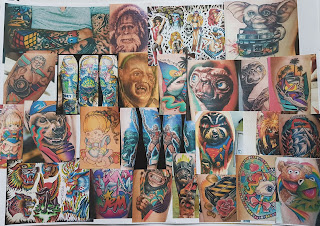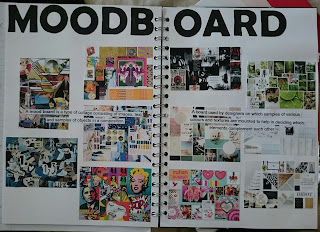Exercise: A Tattoo
A Tattoo
21/07/2018
' A friend has asked you to design a tattoo for them based on the word mum. He would also like you to make it into a greetings card that he can send his mother for Mothers Day.
Research the history and conventions of tattoos and body art, as well as the modern ranges look at the designs from the past and other cultures.
Decide on how complex your design will be and whether you will be using colour.
Draw up your design on a large scale.
Write up your decision making in your Learning Log.'
History of Tattoo's
It is arguably claimed that tattooing has existed since 12,000
years BC. The purpose of tattooing has varies from culture to
culture and its place on the time line.
Tattoos have always had an important role in ritual and
tradition. In Borneo, women tattooed their symbols on their
forearm indicating their particular skill. If a woman wore a
symbol indicating she was a skilled weaver, her status as prime
marriageable material was increased. Tattoos around the wrist and
fingers were believed to ward away illness. Throughout history
tattoos have signified membership in a clan or society. Even
today groups like the Hells Angels tattoo their particular group
symbol.
In recorded history, the earliest tattoos can be found in
Egypt during the time of the construction of the great pyramids. When the Egyptians
expanded their empire, the art of tattooing spread as well. The
civilisations of Crete, Greece, Persia, and Arabia picked up and
expanded the art form. Around 2000 BC tattooing spread to China.
The Greeks used tattooing for communication among spies.
Markings identified the spies and showed their rank. Romans
marked criminals and slaves. This practise is still carried on
today. The Ainu people of western Asia used tattooing to show
social status. Girls coming of age were marked to announce their
place in society, as were the married women. The Ainu are noted
for introducing tattoos to Japan where it developed into a
religious and ceremonial rite. In Borneo, women were the
tattooists. It was a cultural tradition. They produced designs
indicating the owners station in life and the tribe he belonged
to. Kayan women had delicate arm tattoos which looked like lacy
gloves. Dayak warriors who had "taken a head" had
tattoos on their hands. The tattoos garnered respect and assured
the owners status for life. Polynesians developed tattoos to mark
tribal communities, families, and rank. They brought their art to
New Zealand and developed a facial style of tattooing called Moko
which is still being used today. There is evidence that the
Mayan, Incas, and Aztecs used tattooing in the rituals. Even the
isolated tribes in Alaska practised tattooing, their style
indicating it was learned from the Ainu.
In the west, early Britons used tattoos in ceremonies. The
Danes, Norse, and Saxons tattooed family crests (a tradition
still practised today). In 787 AD, Pope Hadrian banned tattooing.
It still thrived in Britain until the Norman Invasion of 1066.
The Normans disdained tattooing. It disappeared from Western
culture from the 12th to the 16th centuries.
22/07/2018
I started with 3 moodboards, One is 80's styled tattoos, Modern Tattoo's and then Mum Tattoos:
Looking at these moodboards I decided that I wanted to do a modern tattoo style. I remembered the Mandala style that hit the UK by storm.
Mandala Meaning
Mandala is a Sanskrit word of 'Circle', and as a tattoo, is composed of shapes and symbols that radiate from the centre outwards in a circular pattern. Like a circle, mandala is meant to reflect balance, eternity and perfection. The distance from the centre of the circle to all points on it remains the same. The Mandala is a unique design that emulates this sense of harmony.
I feel that with what Mandala stands for its the perfect tattoo design for 'Mum'.
So, I printed of a few mandala pictures and did some sketches of what was already out there to get a feel for it:
 |
| Sketchbook |
 |
| Sketchbook |
After getting the feel for drawing Mandala designs, I went straight ahead and started designing this tattoo:
 |
| Tattoo Design Pencil |
After I was happy with my design in pencil, I then went straight ahead and drew it in pen:
 |
| Final Design in Pen |
After drawing the design out in pen, I took the design into Photoshop and developed it in there:
 |
| Final Design in Photoshop |
I added the 'Mum' at the top of the design as its most fitting there, I chose CalliGravity Type. I feel this fits the design perfectly.
I then went onto design of the card and I kept it simple, just plain white background:
 |
| Photoshop Design Card |
 |
| Design on the Card |
After seeing my design on the front of a card that I design I felt it needed more colour. Looking back at the modern moodboard I created I have seen that we use watercolours in our tattoo's now, so I took this inspiration and applied it to my design. Here are the results:
 |
| Photoshop Design Card |
 |
| Design on the Card |
I feel that adding the colour to the Tattoo was the right decision and I am happy wit the end results, It also works well on a card design for Mother's Day.






Comments
Post a Comment